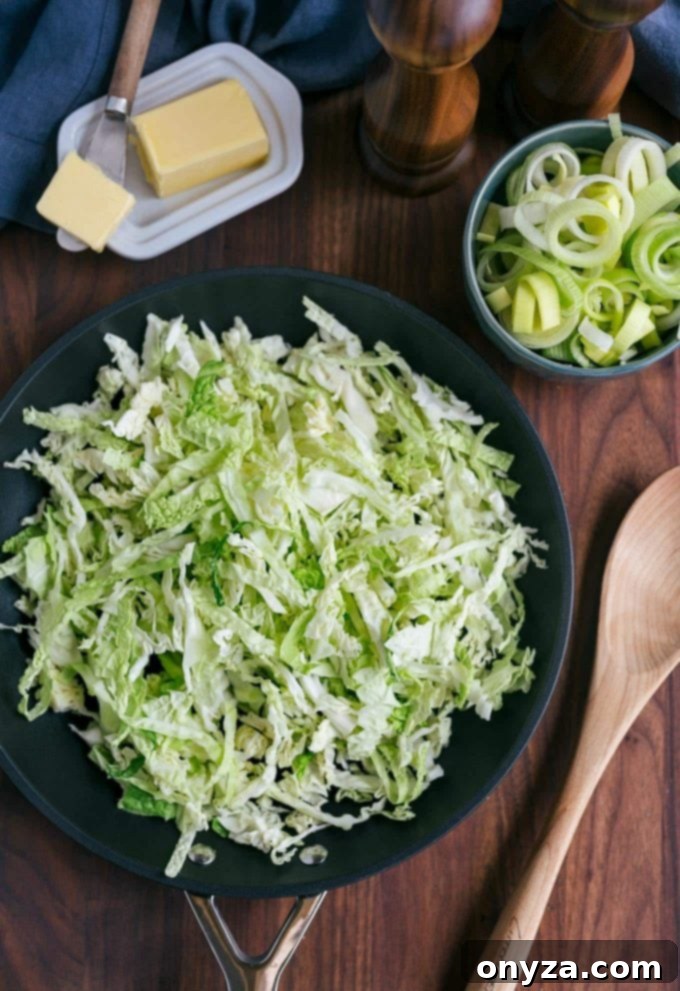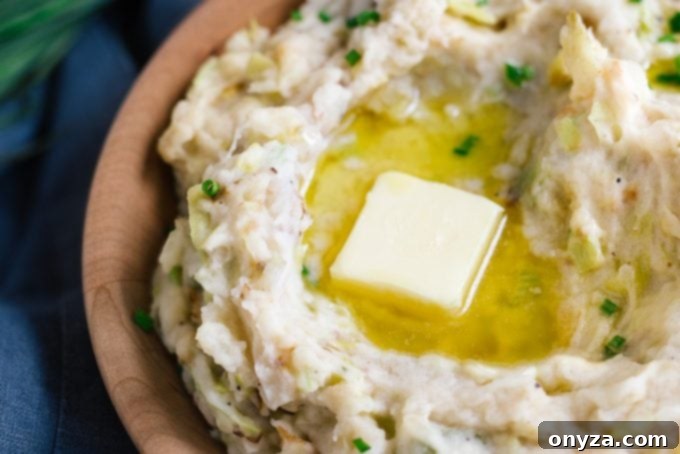Discover the magic of authentic Irish comfort food with our incredibly rich and creamy Colcannon recipe. This beloved classic combines fluffy mashed potatoes with tender Savoy cabbage, sweet caramelized leeks, and a hint of fragrant garlic. Crown each serving with a generous drizzle of melted Irish butter for an irresistible addition that will elevate your St. Patrick’s Day celebration or any comforting family meal!
The Ultimate Creamy Leek and Cabbage Colcannon: A St. Patrick’s Day Essential
Just a few years ago, the delightful experience of Colcannon was completely foreign to me. Despite hearing countless mentions of this iconic Irish potato dish, St. Patrick’s Day would annually arrive and depart without a single serving gracing my table. It wasn’t until I finally decided to dive into making it myself that I truly understood what I had been missing. Each buttery spoonful was a revelation, evoking a surprising mix of emotions – dramatic as it sounds, it was profoundly true. The potatoes were simply incredible: rustic, hearty, and yet wonderfully fluffy, unlike any other potato dish I had ever encountered.
As a true devotee of good mashed potatoes, I was thoroughly annoyed with myself for having waited so long. To think of all the St. Patrick’s Day dinners I could have elevated and made truly special with a hearty bowl of Colcannon! The experience was a delicious lesson learned, and since that first unforgettable bite, Colcannon has become a cherished staple in my kitchen. I’ve experimented with several flavor variations, but this particular recipe, featuring tender sautéed Savoy cabbage and sweet leeks, has unequivocally become our family’s absolute favorite. It pairs exquisitely with traditional Irish fare like my Beer Braised Corned Beef, Instant Pot Corned Beef, or Slow Cooker Corned Beef, and is equally superb alongside succulent lamb, or even a classic roasted chicken. Simply put, whether it’s St. Patrick’s Day or any evening that calls for a soul-satisfying, “grab-a-spoon-and-dig-in” potato side, this Colcannon recipe is an absolute must-try!

What Exactly Is Colcannon? A Dive into Irish Culinary Tradition
The name “Colcannon” itself is Irish, meaning “white-speckled cabbage,” a delightful nod to its primary ingredients. This classic Irish dish is traditionally a comforting blend of creamy mashed potatoes and vibrant greens. While recipes can vary widely by region and even by individual cook, the most common additions to the potatoes are kale and/or cabbage. It’s a dish deeply rooted in Irish heritage, often enjoyed during colder months or as a festive accompaniment, particularly around Halloween and St. Patrick’s Day.
As someone who has often expressed a strong affinity for leeks, exploring a leek-infused Colcannon was high on my culinary agenda. The resulting combination truly captured my heart: the delicate sweetness of caramelized leeks, perfectly complementing the tender cabbage and the incredibly creamy mashed potatoes. This unique blend adds a layer of sophisticated flavor that distinguishes it from more basic versions.
Many traditional Colcannon recipes suggest boiling the vegetables directly with the potatoes until everything is tender. However, contemporary variations often opt for a sautéing or pan-roasting method for the greens. After meticulously testing both approaches, I unequivocally prefer to sauté the vegetables. This technique allows the cabbage and leeks to develop a beautiful caramelization, which in turn imparts a profound depth of flavor to what would otherwise be a relatively blank canvas of mashed potatoes. This subtle char and sweetness from sautéing elevate the entire dish, creating a more complex and satisfying experience.

Choosing the Best Potatoes for Colcannon: The Secret to Perfect Creaminess
The foundation of any exceptional Colcannon lies in the choice and preparation of its potatoes. Traditionally, this dish is crafted using either russet or red-skinned potatoes. For this particular recipe, I wholeheartedly recommend using russet potatoes. Their naturally higher starch content and lower moisture level are ideal for achieving that coveted fluffy yet creamy texture. They absorb the butter and cream beautifully, creating a luxurious base that perfectly cradles the caramelized vegetables.
For those eager to deepen their potato knowledge, resources like How to Pick a Potato from Kitchn offer excellent insights into selecting the best variety for any given recipe.
Achieving the perfect texture also heavily relies on thorough drainage of your boiled potatoes before they are combined with the other ingredients. A crucial step I always follow is to return the drained potatoes to the hot cooking pot. Allowing them to rest for a few minutes in the residual heat encourages any lingering moisture to evaporate, preventing a watery or gluey consistency. This small detail makes a significant difference in the final product.
As you begin to mash the potatoes and incorporate the half and half, don’t be alarmed if the mixture initially appears a bit too thin. Patience is key here; it often takes a couple of minutes for the liquid to be fully absorbed, transforming into that irresistibly swoon-worthy, creamy consistency we’re aiming for. If, however, you find yourself preferring a denser, sturdier potato base for your Colcannon, you can easily adjust the amount of half and half, starting with 3/4 cup and adding more incrementally until you reach your desired consistency. The Colcannon featured in the photographs for this post was prepared using well-drained potatoes and a full cup of half and half, showcasing its luscious and creamy finish.

The Indispensable Touch: Don’t Forget the Irish Butter!
If there’s one defining element of Colcannon that remains consistently present across all recipes—aside from the potatoes, of course—it is undoubtedly butter, and often, a generous amount of it. Butter plays a dual role in this magnificent dish, contributing richness both within the mashed potatoes themselves, thoroughly blended with the sautéed vegetables, and as a decadent finishing touch. I always make sure to drizzle a generous amount of melted butter over the dish just before serving. This creates a visually appealing and utterly delicious effect: as each scoop of Colcannon is served, the spoon effortlessly glides through a shimmering well of pooled butter in the center of the bowl, ensuring every bite is infused with its luxurious flavor.
For an authentic flavor boost that truly captures the essence of Irish cooking, I highly recommend sourcing and using Irish butter, as I did in this recipe. Irish butter stands apart from many other varieties on the market. It boasts a slightly softer texture, an incredibly fresh, intensely creamy taste, and a distinctive, beautiful golden hue. This superior quality is often attributed to the diet of grass-fed cows in Ireland. Thankfully, many grocery stores are now regularly stocking Irish butter in their dairy sections, making it easier than ever to add this special ingredient to your Colcannon.
Are you hungry yet? The aroma of these gorgeous, creamy potatoes infused with sweet leeks and savory cabbage, waiting for that golden pool of melted Irish butter, is simply irresistible. Grab a spoon and prepare to indulge in a truly comforting and flavorful Irish culinary experience.
Creamy Leek and Cabbage Colcannon Recipe
My Colcannon recipe combines rich and creamy mashed potatoes with Savoy cabbage, sweet leeks, and a touch of garlic. Drizzle the top with melted Irish butter and dig in for an easy addition to your St. Patrick’s Day feast!
Prep Time: 10 minutes
Cook Time: 20 minutes
Total Time: 30 minutes
Servings: 4 servings
Ingredients
- 2 pounds russet potatoes, cleaned, peeled, and cut into 1-inch wedges
- 2 leeks (white and light green parts only), cleaned thoroughly and sliced into 1/4-inch rounds
- 3 cups finely-shredded Savoy cabbage (about 1/4 of a head), packed
- 1 large garlic clove, minced
- 6 tablespoons unsalted butter, divided
- 1 cup half and half *
- Kosher salt and freshly ground black pepper, to taste
- Snipped chives (for garnish)
Instructions
- Prepare the Potatoes: Place the potato wedges in a large pot and cover with cold water. Add a generous pinch of salt. Bring the water to a boil over high heat, then reduce heat to medium-low and simmer until the potatoes are fork-tender, about 15 minutes. You should be able to easily insert a paring knife into the center of a potato piece without resistance. Drain the potatoes thoroughly and immediately return them to the hot, empty pot. Let them stand for a few minutes (3-5 minutes) to allow any remaining moisture to evaporate, ensuring a fluffy mash.
- Sauté the Cabbage: While the potatoes are boiling, melt 4 tablespoons of the unsalted butter in a large skillet over medium-high heat until it is foaming gently and the foam begins to subside. Add the shredded Savoy cabbage to the skillet along with 1 teaspoon of kosher salt and 1/2 teaspoon of freshly ground black pepper. Cook, stirring frequently, for 5-8 minutes, until the cabbage is tender-crisp and just beginning to brown around the edges, developing a subtle sweetness.
- Add Leeks and Garlic: Add the sliced leeks to the skillet with the cabbage and an additional 1/2 teaspoon of salt. Continue cooking, stirring often, for another 5-8 minutes, until both the cabbage and leeks are tender and beautifully caramelized. Stir in the minced garlic and cook for just 1 additional minute until fragrant. Be careful not to burn the garlic.
- Combine and Mash: Remove the skillet from the heat. Pour the half and half into the vegetable mixture. Transfer the sautéed vegetables and half and half directly into the pot with the hot, drained potatoes. Using a sturdy potato masher, thoroughly combine and mash the mixture to your desired consistency. At first, the potatoes might appear a bit loose, but they will naturally thicken as you mash and stand. Taste and adjust seasoning with additional salt and pepper as needed.
- Serve with Butter Drizzle: To serve, mound the creamy Colcannon into a large serving bowl. Use the back of a spoon to create a shallow well or indentation in the center of the potato mound. Melt the remaining 2 tablespoons of butter. Drizzle this melted butter generously over the top of the Colcannon, allowing it to pool beautifully in the central well. Serve immediately, ensuring each scoop catches some of that luscious melted butter. Garnish with fresh snipped chives for a pop of color and fresh flavor.
Notes
- *When first adding the half and half, the mashed potatoes might appear looser than expected. Rest assured, they will thicken naturally as you continue mashing and within about 5 minutes of standing. If you prefer a firmer mashed potato consistency for your Colcannon, start by reducing the half and half to 3/4 cup and adjust as needed.
- For an extra layer of flavor and richness, I highly recommend using Irish butter in this recipe. I typically use unsalted butter within the potatoes themselves to maintain control over the overall saltiness of the dish. However, for the melted drizzle on top, I sometimes opt for a good quality salted Irish butter for an even more luscious and flavorful finish.
Nutrition Estimate
(Please note: Nutrition information is automatically calculated and should be used as an approximation. Actual values may vary based on specific ingredients and preparation methods.)
- Calories: 449 kcal
- Carbohydrates: 53g
- Protein: 8g
- Fat: 24g
- Saturated Fat: 15g
- Cholesterol: 67mg
- Sodium: 56mg
- Potassium: 1193mg
- Fiber: 5g
- Sugar: 4g
- Vitamin A: 1530 IU
- Vitamin C: 38mg
- Calcium: 145mg
- Iron: 3.1mg
Please note that our recipes have been developed using the US Customary measurement system and have not been tested for high altitude/elevation cooking and baking.
Like this recipe? We’d love to hear from you! Rate and leave a comment below to share your experience.
